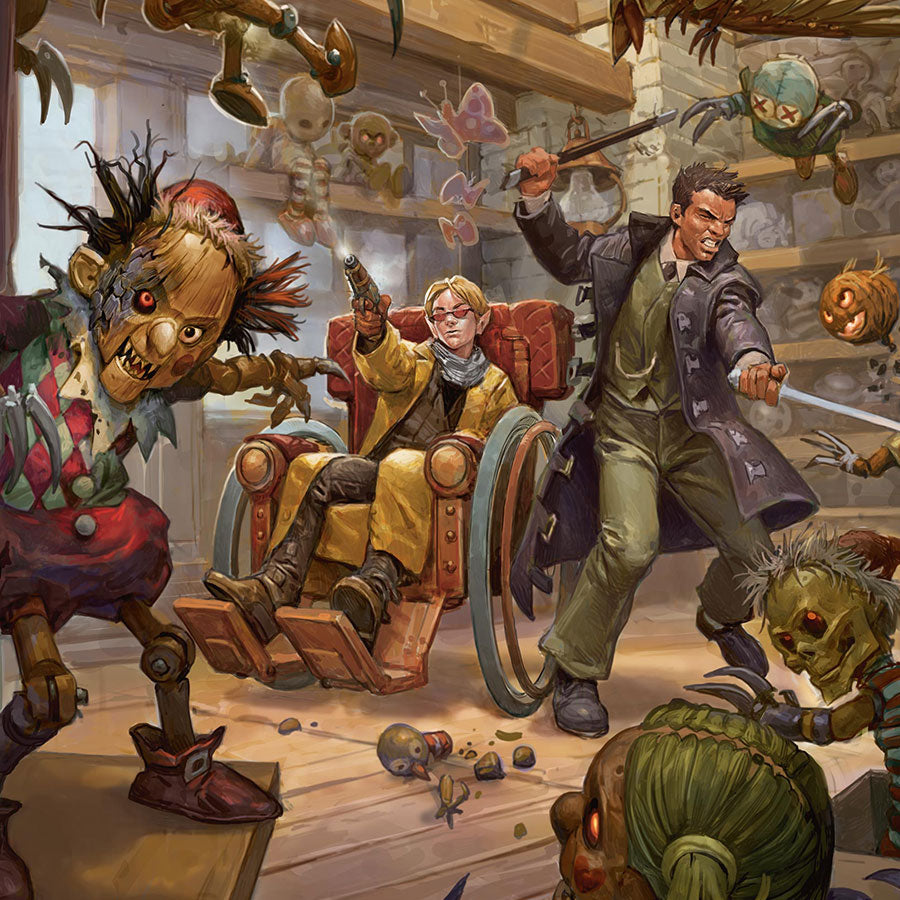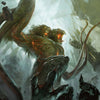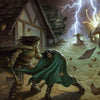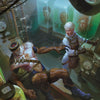How to Make the Perfect Dungeon | D&D Adventure Creation

Today in the DM Lair we’ll be going to go over the seven steps I use when I create homebrew dungeons and adventures for my Dungeons & Dragons games. If you follow these steps, you’ll be creating awesome adventures for your players in no time.
Now, I’ll list these seven steps in the order I usually do them, but feel free to skip around if that works better for you. And along the way, I’ll be giving some PRO TIPS for making your dungeons more interesting and fun for your players.
Don’t forget to pick up our free RPG Adventure Template, too! It will walk you through the process of designing your own adventures.
By the way, if you’re frustrated with all the missing rules in 5e and looking for some lightweight rulesets you can add to your game, check out our Big Ruleset Bundle. It contains 5e rules for mass combat, sieges, hex crawls, points of interest, crafting, and more.
Watch or listen to this article by clicking the video below.
#1 Determine the Storyline
The first step to making a dungeon or adventure is decided what the main problem is, what the central tension is. Why do your players’ characters even need to go into the dungeon to begin with? I mean, why not just stay home and knit booties for the grandkids?
Or whatever it is your players’ PCs do in their downtime… Because knitting booties, you know, is kind of …yeah...
Okay, yeah, so uh, anyway, if you’re stuck on creating the storyline or central tension, and have no idea where to begin, I usually get my inspiration for an adventure or dungeon from the Monster Manual, Volo’s Guide to Monsters, or Mordenkainen’s Tome of Foes.
Basically, I just get all hopped up reading about different monsters and their lore and then that inspires me to create a dungeon.
Once I find some creatures I want to throw in a dungeon and make an adventure out of, I ask myself a few questions: What do these creatures want? And what are they doing that is causing problems in the game world?
Answering those two questions is the foundation for creating an amazing Dungeons & Dragons adventure that your players will remember for years to come.
For instance, let’s say an evil hag wants to corrupt children and steal their souls. Well, she could go out and just kidnap them, but that’s a little obvious. Instead, how about she disguises herself as a kind old lady in town that passes out candies to children?
Now, the candies are delicious and have no obvious side effects, but they slowly turn the children more and more evil. It starts with mean pranks, and then intensifies into something much worse. And then, when a child commits some horrible atrocity, its soul then belongs to the hag.
See? That’s a problem in the game that needs resolving. That’s an adventure your players could go on: find out what’s corrupting all the local children and put an end to it. And there could be a dungeon—the hag’s lair full of her cruel fey minions—that the players need to delve into.
Now, this step DOES require creativity, but the more you exercise your brain and your mind, the better you’ll get at it. My suggestion is to put in the effort and work at this. Don’t take short cuts like going to Facebook or Reddit and querying the “hivemind” there for ideas. That will only inhibit your own ability to come up with ideas for your own awesome dungeons and D&D adventures.
#2 Pick Some Monsters for the Dungeon
Now, yes, you’ll probably already have done this a little bit as part of determining the storyline, but now’s the time to find some more baddies to stick and the dungeon and flesh things out a little more.
Who’s working for the main villain of the adventure? Have you even found a creature to be the main villain yet?
And why are all these creatures and monsters in the same dungeon? Are they working together? Are there different factions in the dungeon that have an uneasy alliance that the players might take advantage of, pitting one against the other? Will the players walk into a dungeon with different sides at war with each other?
You see, as I’m picking out my monsters, I’m asking myself all these questions. This helps me flesh out the details of the dungeon and ensure that the dungeon makes sense.
I feel like many old school dungeons just had tons of monsters crammed into the different rooms, but there was no rhyme or reason to it. If the players ever stopped to ask “why?”, there’d probably be no good answer. And, honestly, a dungeon like that feels kind of lame to me.
So when you choose monsters for your dungeon, make sure that the dungeon ecology makes sense. That is, there’s a reason all the monsters are there in the dungeon, coexisting together.
#3 Develop Important NPCs and Locations
I like to flesh out some details about the important NPCs and locations my players will come across in the dungeon or on the adventure.
For instance, let’s say the dungeon is near the halfling town of Undercliff just east of Waterdeep, and there’s a good chance the players will go in the town. Well, I should probably have some basic information about that town developed shouldn’t I?
Now, I’m not necessarily going to build out an entire town, but I may want to know some basic facts. Who’s the mayor? What’s the main lively hood of the people there? You know, basic stuff that’s likely to come up if the players go there.
And then, let’s flesh out some NPCs, perhaps the main villain of the dungeon and any other important NPCs the players will come across.
How about that hag who’s stealing children’s souls? Well, I had better know her name at minimum: Granny Mathilda Tichwillow. And I should know what she looks like, her basic mannerisms, her goals, what motivates her, and perhaps a flaw that could be used against her.
I do the same sort of basic outlining for any important NPCs in the adventure or dungeon itself.
#4 Make the Dungeon Already!
Okay, maybe up until this point you’ve been thinking, that’s all great, Luke, but I thought we were talking about MAKING DUNGEONS here. So, why all the foreplay? Why not just get straight to the point?
Because, young padawan, you don’t bake a cake without first reading the recipe and buying the ingredients. – Do padawan’s bake cakes? Aren’t they just Jedi Knights in training? Or did Disney screw that up, too? Eh, whatever, you get the point though…
Anyway, let’s create the actual dungeon, eh? And any good dungeon—or castle, or building, or whatever—usually starts with a map.
And a quick side note on terminology before we go on: pretty much everything is a dungeon in my mind. Anything with ROOMS made of four walls, a ceiling—and preferably a floor—connected by CORRIDORS, is a dungeon for the purposes of this conversation.
Call it a hidden tomb, an ancient temple of a forgotten evil god, the castle of the incredibly beautiful princess who must needs be rescued, or the rat-infested cellar of the local grocer: those are all dungeons in my book.
Okay, back to maps because a good dungeon needs a good map. And the best advice I can give you for creating a good dungeon map is STEALING IDEAS FROM OTHERS.
That’s right, I am advocating theft!
Creativity feeds on creativity, so when I’m looking to make a map for a dungeon, I start with a quick Google search for maps. Just type in “D&D map”, press enter, and then go to the “images” tab – and you’re all set.
Just browse through the maps, maybe refine your search for sewers or temples, and then when you find something you think looks cool, use that for inspiration. Now, usually, I prefer not to copy a map exactly as I find it, instead I like to make tweak it and make it my own.
And, honestly, a lot of times the map I finally end up creating looks very little like the map—or maps—that inspired me, and that’s perfectly fine. I went to Google for inspiration, not to steal a map.
Unless, of course, I did…
Then, once you have your map created, you just need to place all your monsters and the villain in it, and write up some brief descriptions for all the rooms.
Oh, and if you need help deciding what each room should be, or the different kinds of furnishing or appointments to place in it, Appendix A: Random Dungeons of the Dungeon Master’s Guide has some awesome lists to help get the creative juices flowing.
And, as you are fleshing out the details of the dungeon, here is a quick-fire lists of things you’ll want to consider placing in your dungeon to keep things interesting, dynamic, and fun for your players:
- Puzzles
- Traps
- Exploration opportunities such as secret doors and passages
- Social interaction scenes where players can have talky-talky moments instead of just combat
- Red herrings intended to throw your players off
- Interesting twists on overdone motifs or clichés.
When you include these sorts of things, your dungeon becomes far more interesting and fun for your players than just room after room of bad guys to fight.
Now, the encounters and the boss fight are still incredibly important, of course. Those are the things that drive many players to actually play the game, so I wouldn’t skimp on those either.
In fact, I have an entire Encounter Building playlist with lots of information about making fun and exciting encounters for your players, and I have a two-part How to Make a Perfect Boss Fight article, too.
#5 Create the Plot Hook
Okay, you got a great idea for a storyline. You picked out the perfect villain and some awesome minions to go along with her. And you created an entire dungeon for your players to explore, with puzzles to solve, traps to overcome, and baddies to defeat.
Well, all of that work is for NOTHING if you can’t motivate your players to actually go to the dungeon and go on the adventure. This is where the PLOT HOOK, or inciting action, comes in.
When I create a plot hook, it consists of two things: a statement of the problem to be solved, and a reason for the players to go solve it.
And bear in mind that not all players are motivated by the same thing. Sometimes just doing the right thing will do the trick, but other times promises of gold, treasure, and even magic items may be needed. Whatever it is, make sure you’re including something that will appeal to your player’s characters.
I often use an NPC to deliver a plot hook—you know, your standard NPC quest giver—but it doesn’t have to be an NPC. Maybe your players find a mysterious letter under their door, or a message scrawled on a bathroom stall.
I don’t know, use your imagination!
#6 Create Some Random Encounters
As a “just in case” measure, I like to create a handful of thematically appropriate random encounters that I can use for the adventure. I might need them, for instance, when my players take a short rest—or long rest—in the middle of the dungeon and I need some extra baddies to throw at them.
I’ll pick monsters that fit with the theme of the adventure and are appropriate for their level, of course.
#7 Create the Resolution
What happens when your players are done with the dungeon and have defeated the villain or otherwise accomplished their goal? Do they receive a reward from an NPC? Does their favor with a faction increase?
Whatever it is, flesh that stuff out. Having a satisfying resolution ties an adventure up nicely and can even serve as the segue for the next adventure or dungeon.
What’s the Deal with All the Missing Rules for 5e?
Are you frustrated that there are some big gaps in the 5e core game system? You know, entire rulesets that seem to be missing?
Believe me, we feel your pain. And that’s why in the Big Ruleset Bundle we have created several lightweight rulesets to fill in the gaps that the 5e designers left behind:
- Mass Combat
- Sieges
- Hewcrawls
- Points of Interest
- Advanced Poison
- Hexes
- Curses
- Crafting
- And more
Remember, these rules are lightweight, meaning it won’t take you and your players ages to read and learn them!
So, if you’re tired of having to homebrew your own rules or make on the spot adjudications when these situations come up, pick up the Big Ruleset Bundle. Don’t spend another second wondering why it isn’t in the core rulebook.
Also, if you’re looking for information on running Skill Challenges in 5e—another mechanic oddly missing from the game—check out our article on How to Run Skill Challenges in D&D 5e.
-
Posted in
Game Master How-To Articles







